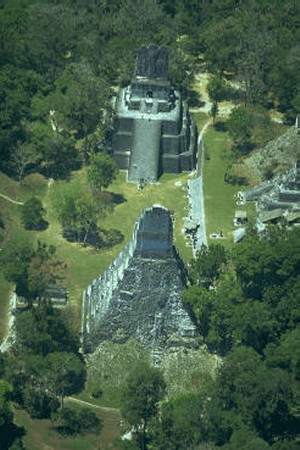
 Much
of human history can be traced through the impacts of human actions upon
the environment. The use of remote sensing technology offers the archeologist
the opportunity to detect these impacts which are often invisible to the
naked eye. This information can be used to address issues in human settlement,
environmental interaction, and climate change. Archeologists want to know
how ancient people successfully adapted to their environment and what factors
may have led to their collapse or disappearance. Did they overextend the
capacity of their landscape, causing destructive environmental effects which
led to their demise? Can this information be applied to modern day societies
so that the mistakes of the past are not repeated? Much
of human history can be traced through the impacts of human actions upon
the environment. The use of remote sensing technology offers the archeologist
the opportunity to detect these impacts which are often invisible to the
naked eye. This information can be used to address issues in human settlement,
environmental interaction, and climate change. Archeologists want to know
how ancient people successfully adapted to their environment and what factors
may have led to their collapse or disappearance. Did they overextend the
capacity of their landscape, causing destructive environmental effects which
led to their demise? Can this information be applied to modern day societies
so that the mistakes of the past are not repeated?
Remote sensing can be used as a methodological procedure for detecting,
inventorying, and prioritizing surface and shallow-depth archeological information
in a rapid, accurate, and quantified manner. Man is a tropical creature
who has invaded every environment on earth successfully; now we are ready
to explore, and eventually colonize, the delicate environments of Space.
Understanding how ancient man successfully managed Earth is important for
the success of current and future societies.
"The stereotype has archaeologists just digging up spearheads and
pottery and anthropologists just writing down the words of primitive tribes.
But we're examining how people adapted to their environment throughout time,
how they experienced environmental shift, why cultures come and go. Soils
associated with artifacts are as important as the artifacts themselves--probably
more relevant to us than the actual objects. Now more than ever, archaeological
research is interdisciplinary: botany, forestry, soil science, hydrology--all
of which contribute to a more complete understanding of the earth, climatic
shifts, and how people adapt to large regions. This understanding is critical
to future decision making affecting the planet.
In Costa Rica, the culture survived repeated volcanic explosions that
repeatedly destroyed the environment, explosions equal to the force of a
nuclear blast. Other cultures, like the advanced Maya societies, did not
survive or recover from similar eruptions. Did it have to do with the size
and violence of the eruption, the way they farmed their land over time,
or territorial and political struggle?" *
Responsible Official: Dr. James L. Smoot (James.L.Smoot@nasa.gov)
Page Author: Tom Sever
Page Curator: Diane Samuelson (diane.samuelson@msfc.nasa.gov)
|


 Much
of human history can be traced through the impacts of human actions upon
the environment. The use of remote sensing technology offers the archeologist
the opportunity to detect these impacts which are often invisible to the
naked eye. This information can be used to address issues in human settlement,
environmental interaction, and climate change. Archeologists want to know
how ancient people successfully adapted to their environment and what factors
may have led to their collapse or disappearance. Did they overextend the
capacity of their landscape, causing destructive environmental effects which
led to their demise? Can this information be applied to modern day societies
so that the mistakes of the past are not repeated?
Much
of human history can be traced through the impacts of human actions upon
the environment. The use of remote sensing technology offers the archeologist
the opportunity to detect these impacts which are often invisible to the
naked eye. This information can be used to address issues in human settlement,
environmental interaction, and climate change. Archeologists want to know
how ancient people successfully adapted to their environment and what factors
may have led to their collapse or disappearance. Did they overextend the
capacity of their landscape, causing destructive environmental effects which
led to their demise? Can this information be applied to modern day societies
so that the mistakes of the past are not repeated?